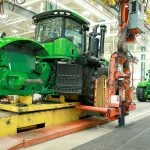What should Ontario’s agri-food industry look like in 25 years?
A group of people from across the sector took a first kick at figuring that out during Agri-Food 2050, an event held Sept. 17 in Niagara Falls organized by the Agricultural Adaptation Council.
Why it matters: Common goal setting and planning across the highly diverse Ontario agri-food sector have been challenging due to the different priorities of sectors.
Event attendees didn’t reach any conclusions or actions, but consulting company Intersol will summarize what was said and create next steps. The event was the beginning of a process, says Melanie DiReto, executive director of the Agricultural Adaptation Council (AAC), which is celebrating its 30th anniversary in 2025.
Read Also

Farmers taking to social media to spread the word about the cost of farm thefts
A rash of farm thefts in Ontario have left farmers looking for new ways to help customers understand the cost of stealing goods.
AAC is the independent organization funded by 64 Ontario agri-food and rural sector groups that serves several functions in the sector, including managing funding programs.
DiReto says the board of directors was looking at what else the organization could do to benefit the sector. Agri-Food 2050 – helping the sector to plan for the future – was one of the places it settled.
“I always say the event is not the end, it’s the beginning, and we really want to be creating action. So AAC sees itself as holding the space for the industry to collaborate and come together to create action over a number of years,” she says.
The 120 attendees were a diverse group from across the industry, including leading university researchers on technical and social issues in agriculture, farmers, representatives of farm organizations, food processors and technology entrepreneurs.
The event split the 120 attendees among several breakout rooms to bring ideas and clarity to the larger group on four defined areas.
These four areas were identified by a group of people brought together from across the industry to help focus the debate in advance of the Sept. 17 event.
They included:
- Economics, especially access to capital
- Social factors, including labour
- Environment and resources, including climate change impacts
- Innovation and technology, which included the future impacts of artificial intelligence
Intersol used an AI bot to summarize the input from the breakout sessions and, with some help from humans, created a list of priorities.
Those four highest priorities were then discussed in another group of breakout sessions including:
- Access to capital and land
- Perception shift and public narrative
- Policy productivity and food sovereignty
- Value chain resilience and localization
The goal was to identify priorities or ways forward in these areas, but when the groups reported on their discussions, most did not produce next steps on their areas of focus.
A panel at the end of the day, including Michael Keegan, of Michael Keegan and Associates, who consults for agriculture organizations, Rene Van Acker, president of the University of Guelph and Dana McCauley, CEO of the Canadian Food Innovation Network, summarized what they heard.
Keegan says it is critical for the agriculture sector to find its potential. “Words like opportunities should be followed by imperative and obligation.”
However, he says it’s clear that with a rapidly changing world where the future will look different than the past, “the tools that we need to employ are either unclear, don’t exist, or are immature.
“A purpose needs to be paramount, with the capabilities to get there,” he said.
He also called for clarity on what will be asked of governments by the sector.
Van Acker lauded the diversity of the sector in the same room, which he says rarely happens.
McCauley echoed numerous people during the day who suggested that there needs to be an urgency to moving forward.
“We keep having these great, deep conversations, and people keep sharing wonderful ideas, but we have to unlock the ears of the people who can move them forward at scale,” she said.
DiReto says the AAC is committed to continuing the process.
“In everyone’s day to day, you face your problems of today, and not everyone has the time or the resources to sit back and think of the future, let alone to sustain the visioning that’s required to set up for a really successful 2050,” she says.













